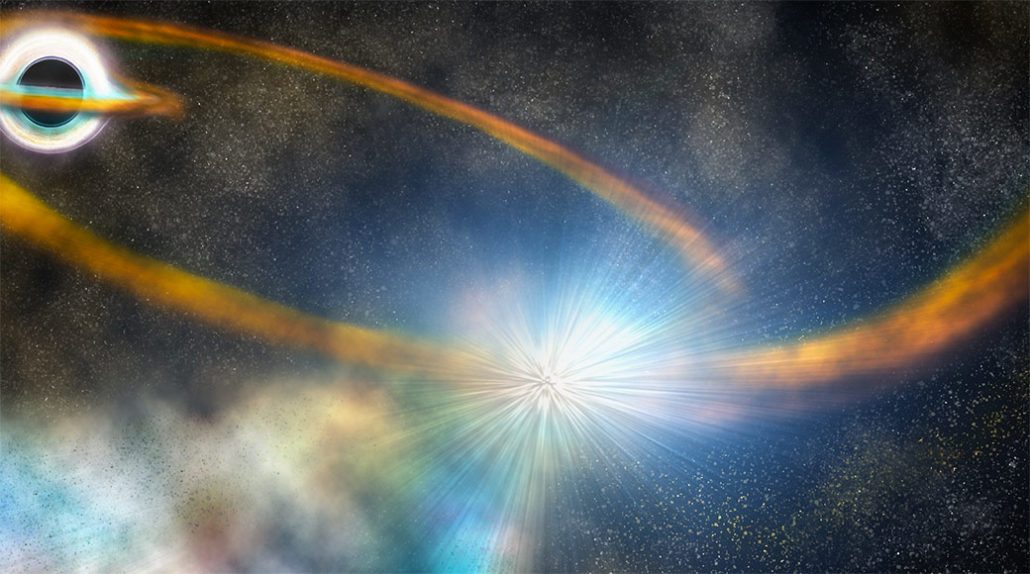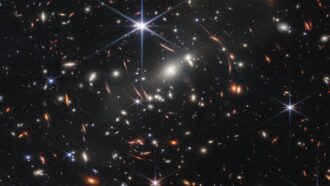A black hole slashed a star apart — and was caught in the act
Witnessing such events can help scientists learn about supermassive black holes

A star that wanders too close to a black hole (top left) is stretched into a thin strand. Some of the star material is thrown back into space, as this illustration shows. The rest swirls around the black hole, crashing into itself and forming a disk of superheated gas.
Robin Dienel/Carnegie Institution for Science
Every so often, a celestial slasher film plays out in the heavens: The villain is a supermassive black hole, which shreds a star and then swallows part of it. Now scientists have gotten a rare, early glimpse of this violent action.
The episode was described September 26 in Astrophysical Journal. It was first detected by telescopes in January. Scientists named the event ASASSN-19bt. It’s one of only dozens of these phenomena ever observed. Such events are known as tidal disruption events.
These occur when a star passes close enough to a black hole to get sucked in and torn apart. In any given galaxy, that usually occurs only about once every 100,000 years, notes Suvi Gezari. She is an astronomer at the University of Maryland in College Park who was not involved with the work. She describes the new observation as “really exciting.”
The first clues that scientists saw from ASASSN-19bt came from robotic telescopes. They had been searching the sky for supernovas. These are violent explosions that mark the death of massive stars. The telescopes detected a bright flare. Researchers then turned to other instruments for a better look. The flare came from a galaxy around 375 million light-years from Earth.
As it happened, that patch of sky also was being watched by NASA’s TESS satellite. It searches the sky for exoplanets. These are planets that orbit stars outside of Earth’s solar system. TESS data is captured every 30 minutes. It showed the stellar material brightening as it began circling the black hole.
“We were able to see exactly when it started to get brighter,” says Thomas Holoien. He’s an astronomer at the Carnegie Observatories in Pasadena, Calif. That’s the earliest observation of a tidal disruption event yet.
Shredding a star
The event was energetic. It released about 30 billion times the energy of our sun. A typical galaxy contains around a billion or 10 billion stars. “So this was outshining every other star in its galaxy,” Holoien says. If such an event happened in the Milky Way, it would be so bright that it could probably be seen during the day.
As the star was drawn in by the black hole, it was pulled apart by the black hole’s intense gravity. Eventually the star was stretched into a long strand of gas. This is called “spaghettification.” Some of the shredded stellar guts were spit back into space. The rest looped around the black hole, crashing into itself. In the end, it formed a spiraling ring of glowing, hot gas. That ring is known as an accretion disk.
NASA Goddard Space Flight Center
The accretion disk is like “water circling the drain of a bathtub,” explains Nicholas Stone. He works in Israel at the Hebrew University of Jerusalem. Stone was not involved with the work. But he collaborates with one of the paper’s authors. As a theoretical astrophysicist, Stone uses computer simulations to study objects in space.
The swirling material is “superheated, interstellar gas. But it still behaves like a fluid,” Stone explains. As it orbits the black hole, the gas rubs against itself. It heats up to hundreds of thousands or even millions of degrees Celsius. And it emits a lot of radiation.
“It’s a little paradoxical,” Stone says, “because you think of black holes as dark objects. But in reality, they can power some of the brightest sources of light in the universe.” More early observations of tidal disruption events could help physicists improve estimates of the masses of black holes. Such observations could also improve estimates of how quickly black holes spin, Stone says.
These data also could help answer how black holes form, Holoien adds. One lingering question is whether this type of star-shredding activity plays a part in how galaxies change over time. “This star died, but we’re able to use its death to learn about the universe.”







